Gawrych George W. The 1973 Arab-Israeli War: The Albatross of Decisive Victory (Leavenworth Papers No.21)
Подождите немного. Документ загружается.


55
losses
the
previous
day,
and
without
any
gains,
although
Reshef
did
extricate
the
garrison
from
the
Purkan
strongpoint.
Upon
learning
of
Sharon's
brash
action,
Elazar
became
livid.
But
rather
than
remove
Sharon,
a
controversial
but
innovative
commander
with
political
connections
to
the
opposition
party,
Elazar
opted
to
replace
Gonen.
Though
a
hero
in
the
Six
Day
War,
Gonen
lacked
the
character
and
temperament
to
be
a
theater
commander.
Furthermore,
his
two
subordinates,
Adan
and
Sharon,
had
once
been
his
superiors,
which
further
complicated
matters.
Gonen's
worst
flaw,
however,
was
that
he
remained
preoccupied
with
current
tactical
events.
As
Elazar
remarked
later:
"I
think
about
tomorrow
.
.
.
That's
my
job.
Whoever's
shooting
now,
neither
the
front
commander
nor
I
can
help
anymore.
That's
a
divisional
commander's
problem.
I'm
constantly
telling
him:
Shmulik
[Gonen],
let's
talk
about
what
will
happen
tomorrow."
102
Gonen
had
failed
to
transition
from
being
a
tactical
to
an
operational
commander.
Part
of
Gonen's
problem
was
that
the
Egyptians
maintained
the
initiative—something
the
Israelis
found
unfamiliar
and
unsettling.
But
Elazar
could
not
avoid
the
critical
issue
of
competent
command,
and
he
decided
to
replace
Gonen
with
former
chief
of
the
General
Staff,
Haim
Bar-Lev.
Although
beset
with
his
own
share
of
problems
in
controlling
Sharon,
Bar-Lev
brought
a
firmer
hand
to
the
Sinai
theater.
To
avoid
the
appearance
of
firing
Gonen,
Elazar
retained
the
general
as
a
deputy
to
the
front
commander
when
Bar-Lev
assumed
command
on
10
October.
The
next
major
round
in
the
struggle
would
come
in
less
than
four
days.
By
10
October,
both
the
Egyptians
and
the
Israelis
had
settled
into
their
own
version
of
an
operational
pause.
During
this
phase
in
the
war,
Egyptian
forces
conducted
probing
attacks
designed
to
expand
their
bridgeheads
to
at
least
the
Artillery
Road,
while
the
Israelis,
for
the
most
part,
proceeded
to
foil
these
efforts.
Elazar
suspended
offensive
operations
based
on
military
necessity—the
IDF
could
ill
afford
launching
simultaneous
offensives
on
two
fronts,
and
the
Israelis
were
not
yet
finished
with
the
Syrians.
Although
Northern
Command
had
pushed
the
Syrian
Army
off
the
Golan
Heights
by
10
October,
the
Israelis
wished
to
finish
off
the
Syrian
Armed
Forces
before
turning
to
the
Sinai
front.
Consequently,
on
10
October,
the
Israeli
cabinet
approved
an
offensive
into
Syria
with
the
goal
of
moving
within
artillery
range
of
Damascus
by
capturing
Sasa.
With
this
drive,
the
Israelis
hoped
to
take
Syria
effectively
out
of
the
war
by
forcing
Asad
to
accept
a
cease-fire.
The
attack
began
at
1100
on
11
October.
Despite
the
Egyptians'
strong
position,
Sadat
could
not,
for
political
reasons,
ignore
the
military
situation
on
the
Golan.
The
Syrian
inability
to
capture
the
Golan
Heights
and
their
forced
retreat
back
into
Syria
had
complicated
matters
for
the
Egyptian
president.
At
the
beginning
of
the
war,
Syria
threatened
Israel
directly,
forcing
the
IDF
to
focus
their
main
effort
on
the
northern
front.
By
9
October,
however,
the
military
situation
was
becoming
desperate
for
the
Syrian
Armed
Forces,
and
pleas
for
help
from
Damascus
were
becoming
more
pronounced,
eventually
com-
pelling
Sadat
to
make
a
tough
decision.
On
11
October,
a
special
emissary
from
Asad
arrived
in
Cairo
appealing
to
the
Egyptians
to
launch
a
major
attack
toward
the
passes
to
relieve
Israeli
pressure
on
the
Golan
front.
Sadat
was
pressed
to
respond
positively.
To
abandon
Syria
would
have
undermined
his
credibility
in
the
Arab
world
after
the
war,
and
Egypt
relied
heavily
on
financial
assistance
from
oil-producing
countries
like
Saudi
Arabia
and
Kuwait.
Sadat
was
therefore
compelled,
out
of
political
and
economic
necessity,
to
demonstrate
solidarity
with
the
Arab
cause
against
Israel.
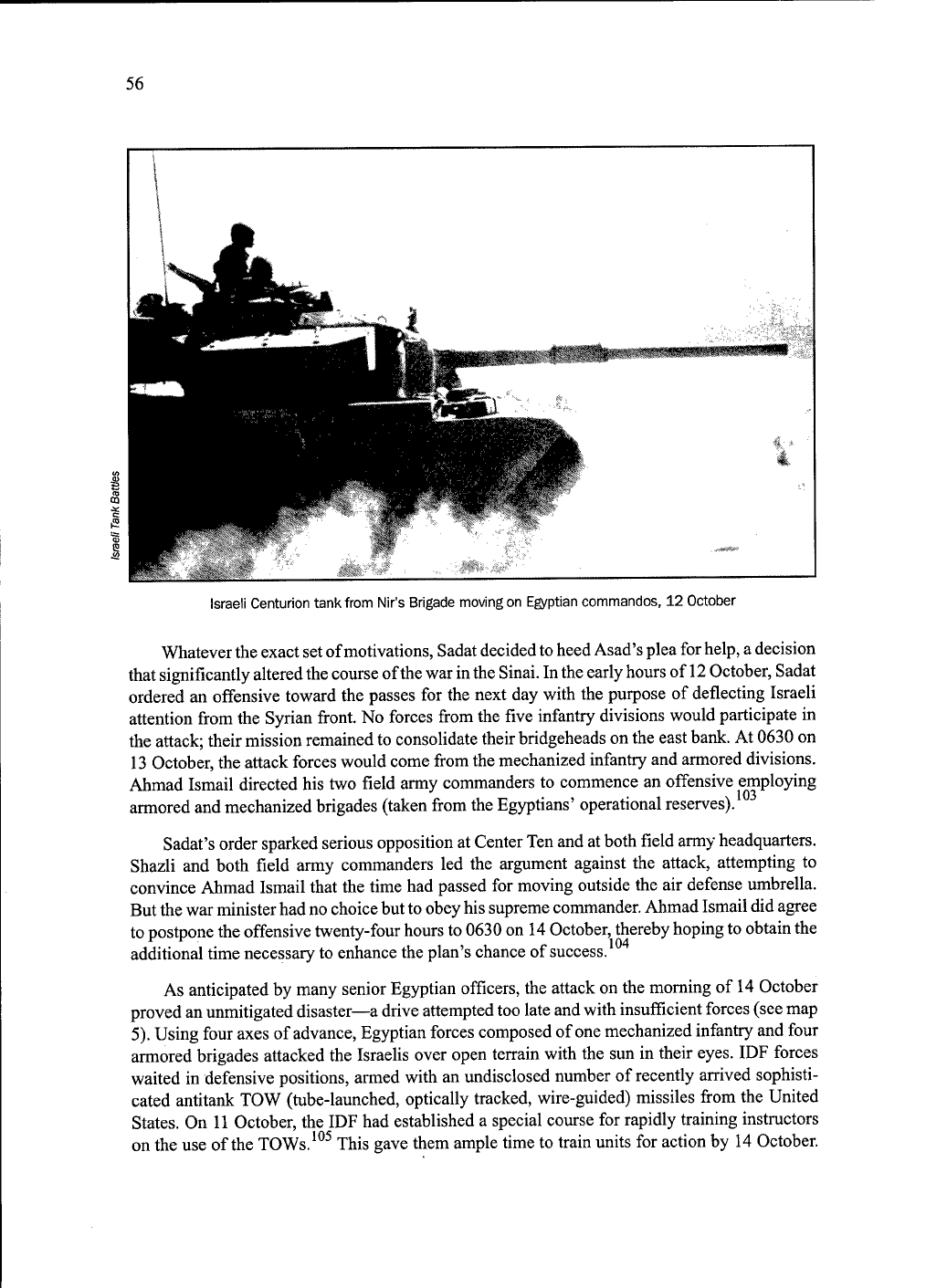
56
Israeli
Centurion
tank
from
Nir's
Brigade
moving
on
Egyptian
commandos,
12
October
Whatever
the
exact
set
of
motivations,
Sadat
decided
to
heed
Asad's
plea
for
help,
a
decision
that
significantly
altered
the
course
of
the
war
in
the
Sinai.
In
the
early
hours
of
12
October,
Sadat
ordered
an
offensive
toward
the
passes
for
the
next
day
with
the
purpose
of
deflecting
Israeli
attention
from
the
Syrian
front.
No
forces
from
the
five
infantry
divisions
would
participate
in
the
attack;
their
mission
remained
to
consolidate
their
bridgeheads
on
the
east
bank.
At
0630
on
13
October,
the
attack
forces
would
come
from
the
mechanized
infantry
and
armored
divisions.
Ahmad
Ismail
directed
his
two
field
army
commanders
to
commence
an
offensive
employing
armored
and
mechanized
brigades
(taken
from
the
Egyptians'
operational
reserves).
Sadat's
order
sparked
serious
opposition
at
Center
Ten
and
at
both
field
army
headquarters.
Shazli
and
both
field
army
commanders
led
the
argument
against
the
attack,
attempting
to
convince
Ahmad
Ismail
that
the
time
had
passed
for
moving
outside
the
air
defense
umbrella.
But
the
war
minister
had
no
choice
but
to
obey
his
supreme
commander.
Ahmad
Ismail
did
agree
to
postpone
the
offensive
twenty-four
hours
to
0630
on
14
October,
thereby
hoping
to
obtain
the
additional
time
necessary
to
enhance
the
plan's
chance
of
success.
As
anticipated
by
many
senior
Egyptian
officers,
the
attack
on
the
morning
of
14
October
proved
an
unmitigated
disaster—a
drive
attempted
too
late
and
with
insufficient
forces
(see
map
5).
Using
four
axes
of
advance,
Egyptian
forces
composed
of
one
mechanized
infantry
and
four
armored
brigades
attacked
the
Israelis
over
open
terrain
with
the
sun
in
their
eyes.
IDF
forces
waited
in
defensive
positions,
armed
with
an
undisclosed
number
of
recently
arrived
sophisti-
cated
antitank
TOW
(tube-launched,
optically
tracked,
wire-guided)
missiles
from
the
United
States.
On
11
October,
the
IDF
had
established
a
special
course
for
rapidly
training
instructors
on
the
use
of
the
TOWs.
1
05
This
gave
them
ample
time
to
train
units
for
action
by
14
October.

57
By
the
early
afternoon
of
14
October,
the
Egyptians
were
in
full
retreat
back
to
their
bridgeheads,
leaving
behind
some
250
destroyed
tanks—which
surpassed
the
240
tanks
that
the
Egyptians
had
lost
through
13
October!
I
06
The
losses
can
best
be
appreciated
by
citing
concrete
examples.
The
Egyptian
21
st
Armored
Division
began
the
war
with
approximately
280
tanks,
124
tanks
in
each
of
its
two
armored
brigades
and
31
tanks
in
its
mechanized
infantry
brigade.
For
the
crossing
operation,
General
Command
had
attached
one
armored
brigade
to
the
16th
Infantry
Division;
the
remainder
of
the
21st
Armored
Division
had
formed
the
operational
reserve
on
the
west
bank.
To
conduct
the
14
October
offensive,
General
Command
transferred
the
remainder
of
the
division
to
the
east
bank
with
the
order
to
attack
toward
Bir
Gifgafa.
By
the
end
of
the
day,
the
1st
Armored
Brigade,
which
had
experienced
combat
for
the
first
time,
had
only
sixty-six
tanks
(47
percent
of
its
tanks
having
been
lost),
whereas
the
14th
Armored
Brigade,
already
combat
seasoned
from
the
crossing
operation,
possessed
only
thirty-nine
tanks
(with
69
percent
of
its
force
now
lost).
Fortunately
for
the
division,
the
18th
Mechanized
Infantry
Brigade
saw
no
action
that
day
and
as
a
result
maintained
its
full
complement
of
thirty-one
tanks.
The
21st
Armored
Division
had
thus
lost
over
50
percent
of
its
tank
force
by
the
end
of
14
October
(down
to
136
from
a
prewar
figure
of
280
tanks).
The
Egyptian
3d
Armored
Brigade
from
the
elite
4th
Armored
Division
illustrates
another
example
of
the
lethality
of
the
Sinai
battlefield.
Assigned
to
the
Third
Army's
operational
reserve,
the
brigade
spent
the
first
week
of
the
war
in
relative
calm
on
the
west
bank.
Then,
it
crossed
the
Suez
Canal
during
the
night
of
12—13
October
and
launched
its
fateful
attack
toward
Mitla
Pass
on
the
14th
into
the
waiting
arms
of
the
Israeli
forces.
Starting
with
124
T-55
tanks,
the
Egyptian
brigade
lost
sixty
tanks,
nine
armored
personnel
carriers,
and
virtually
all
of
its
artillery
pieces
in
less
than
eight
hours.
By
midafternoon,
the
brigade
had
retreated
back
into
the
19th
Infantry
Division's
bridgehead
with
its
combat
power
essentially
down
to
that
of
two
tank
battalions.
1
Overall,
the
Egyptians
never
recovered
from
this
major
military
setback,
and
it
remained
for
the
IDF
to
exploit
this
sudden
turn
of
events.
With
this
Egyptian
defeat,
Israeli
commanders
quickly
grasped
that
the
tide
of
war
had
shifted
in
their
favor.
That
night,
Elazar
called
Meir
with
the
good
news
and
gave
his
assessment
of
the
new
strategic
situation
facing
Israel
in
the
Sinai.
"Golda,
it
will
be
all
right.
We
are
back
to
ourselves
and
they
[the
Egyptians]
are
back
to
themselves."
109
Egyptian
losses
supported
Elazar's
optimistic
appraisal,
for
Israeli
intelligence
estimates
placed
the
number
of
Egyptian
tanks
destroyed
at
280—a
loss
that
shifted
the
balance
of
combat
power
to
Israel.
!
l
°
Events
would
prove
that
the
initiative
had
clearly
passed
to
the
IDF,
and,
as
a
result,
the
Egyptian
Armed
Forces
would
display
some
of
the
weaknesses
that
they
had
exhibited
in
their
poor
performance
in
the
Six
Day
War.
Yet,
despite
much
reason
for
optimism,
the
Israeli
political
and
military
leadership
would
learn,
again,
that
the
Egyptians
had
not
completely
reverted
to
their
old
selves.
Rather,
the
Egyptian
Armed
Forces
would
once
again
demonstrate
their
new-found
combat
mettle,
thereby
creating
more
surprises
for
Israel
in
the
latter
part
of
the
war.
The
14th
of
October,
though
an
unequivocal
Israeli
military
success,
carried
with
it
a
painful
side
for
Israel.
After
some
procrastination,
partly
out
of
a
desire
not
to
alarm
the
public,
Elazar
finally
authorized
the
first
official
release
to
the
media
of
casualty
figures:
656
known
dead
Israeli
soldiers
in
the
first
eight
days
of
fighting,
among
them
Major
General
Avraham
Mandler,
the
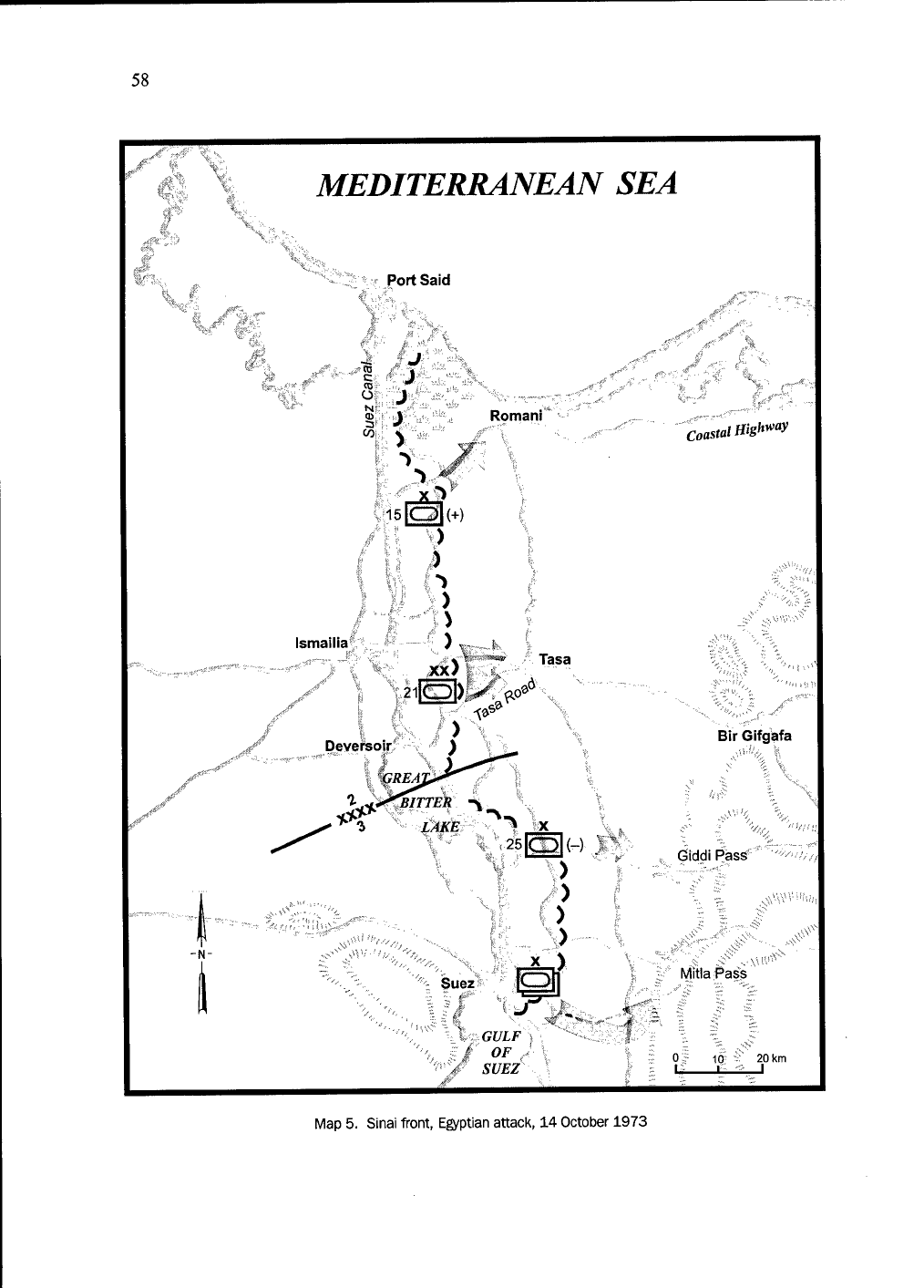
58
MEDITERRANEAN
SEA
Port
Said
Ismailia
Devefsoir
.#
Romani
Tasa
i^AO»"
WREM
BITTER
4
'1
X
25CO(-)
Coastal
High»"*
Bir
Gifgafa
Giddi
Pass
Suez
i
X
[CDU
GULF
OF
f
.
SUEZ
■
t
Mitla
Pass
0
5
10'
-i
20
km
\1
L^i
I
Map
5.
Sinai
front,
Egyptian
attack,
14
October
1973

59
A
tank's-eye
view
during
an
Israeli
holding
action
in
north
Sinai
commander
of
the
252d
Armored
Division,
killed
by
an
artillery
shell
the
day
before.
By
now,
many
Israelis
on
the
home
front
had
realized
that
all
was
not
well
in
the
war,
but
this
first
public
acknowledgment
of
the
numbers
killed
gave
concrete
form
to
the
extent
of
the
human
tragedy
so
far.
In
the
195
6
and
1967
wars,
both
of
less
than
a
week's
duration,
newspapers
had
published
the
names
of
those
killed
in
battle
after
the
end
of
hostilities.
This
time,
however,
military
censors
had
instructions
to
prevent
the
publication
of
any
obituaries
submitted
by
bereaved
families
until
the
end
of
the
war.
Citing
the
need
for
secrecy
at
a
news
conference,
Dayan
admonished
the
nation
to
delay
its
mourning
until
the
resolution
of
the
armed
struggle:
"We
are
in
the
midst
of
war,
and
we
can't
give
public
expression
at
this
time
to
our
deep
grief
for
the
fallen."
His
words
underscored
the
seriousness
of
the
war,
and
Israel's
national
will
focused
on
winning
the
conflict
before
confronting
its
tragic
dimensions.
THE
ISRAELI
RESURGENCE.
The
sheer
magnitude
of
the
military
defeat
shocked,
stunned,
and
demoralized
the
Egyptian
High
Command
and
energized
the
IDF.
While
Egyptian
field
officers
attempted
to
regain
their
composure
and
regroup
their
battered
forces,
senior
Israeli
commanders
prepared
to
take
advantage
of
the
new
strategic
situation
in
the
Sinai.
Late
in
the
evening
on
14
October,
Elazar
approached
the
cabinet,
seeking
approval
for
a
crossing
to
the
west
bank—an
operation
called
Stouthearted
Men.
Confirmation
came
at
approximately
0030
on
15
October.
The
operation
began
with
high
hopes
of
achieving
a
quick
victory
on
the
battlefield.

60
Stouthearted
Men
called
for
three
Israeli
armored
divisions
to
cross
at
Deversoir
on
the
northern
tip
of
the
Great
Bitter
Lakes
and
encircle
the
Egyptian
Third
Army
by
surrounding
Suez
City,
thereby
cutting
off
the
Egyptian
troops
on
the
east
bank
from
their
supply
bases.
Israeli
intelligence
had
estimated
that
the
Egyptians
had
lost
between
250
and
280
tanks
on
14
October,
which
left
them
with
only
700
tanks
operational
on
both
banks
of
the
Suez.
Southern
Command
possessed
roughly
the
same
number
of
tanks
divided
into
four
divisions:
Sharon
240,
Adan
200,
Magen
140,
and
Sasson
125.
Despite
a
roughly
equal
number
of
tanks
on
both
sides,
the
Israelis
could
concentrate
their
armor
at
the
crossing
site
of
Deversoir,
where
the
Egyptians
had
positioned
the
southern
flank
of
the
16th
Infantry
Brigade.
To
meet
the
Israeli
effort,
Brigadier
General
Abd
Rab
al-Nabi
Hafiz,
the
Egyptian
commander
of
the
16th
Infantry
Division,
could
rely
only
on
his
divisional
reserve
and
elements
from
the
battered
21st
Armored
Division.
For
the
crossing
operation,
Sharon's
143d
Armored
Division
would
secure
both
sides
of
the
Suez
Canal
and
the
two
roads,
Akavish
and
Tirtur,
that
led
to
the
crossing
site
on
the
east
bank
(see
map
6).
Adan
would
then
cross
over
with
his
162d
Armored
Division
to
destroy
the
Egyptian
air
defense
system,
thus
allowing
the
Israeli
Air
Force
to
provide
needed
ground
support
as
well
as
threaten
Cairo.
If
all
went
according
to
plan,
the
252d
Armored
Division,
now
under
the
command
of
Brigadier
General
Kaiman
Magen
(who
replaced
the
fallen
Mandler
on
13
October),
would
cross
over
and
relieve
Sharon
on
the
west
bank.
Adan
would
then
race
south
to
capture
Suez
City,
thereby
surrounding
Third
Army.
Sharon,
meanwhile,
would
provide
flank
protection
for
the
dash
south.
To
support
the
effort,
Elazar
planned
to
insert
a
paratroop
force
by
helicopter
to
secure
the
key
position
of
Gebel
Ataka.
Based
on
the
assumption
that
the
Egyptians
had
returned
to
their
form
of
1967,
Operation
Stouthearted
Men
optimistically
planned
for
a
one-day
crossing
of
the
Suez
Canal
and
for
another
day
to
conduct
a
lightning
dash
to
Suez
City
to
encircle
Third
Army.
This
forty-eight-hour
timetable
was
completely
unrealistic.
Again,
the
Egyptians
exhibited
unexpected
resilience,
even
when
confronted
with
Israeli
units
in
their
operational
rear.
Again,
the
Israelis
discovered
that
this
was
not
the
Egyptian
Army
of
1967.
Sharon,
as
noted,
had
received
the
mission
of
securing
the
access
routes
and
crossing
site.
To
draw
Egyptian
attention
away
from
Deversoir,
Raviv's
Armored
Brigade
would
launch
a
diversionary
attack
toward
Televizia
and
Hamutal.
Meanwhile,
Reshef
s
Armored
Brigade,
with
the
mission
of
securing
the
crossing
site
and
the
route
to
it,
would
embark
on
a
southwesterly
route
south
of
Tirtur
and
Akavish
Roads.
Once
on
Lexicon
Road
and
heading
north,
Reshef
planned
to
secure
Deversoir
with
one
force,
push
another
force
north
and
northeast
to
widen
the
crossing
site,
and
send
a
third
force
eastward
to
open
Tirtur
and
Akavish
Roads.
To
facilitate
the
movement
of
troops
and
equipment
across
the
Suez
Canal,
Southern
Command
hoped
to
capture
some
Egyptian
bridges
intact
and
to
bring
forward
its
own
heavy
bridge,
pulled
by
a
tank
company.
After
Reshef
secured
Deversoir,
Colonel
Danni
Matt's
600
paratroopers
would
cross
over
to
the
west
bank
during
the
night
of
15-16
October,
supported
by
a
tank
company
from
Haim
Erez'
Armored
Brigade.
The
remainder
of
Erez'
brigade
would
tow
a
precontracted
bridge
to
Deversoir,
using
Akavish
Road.
Once
in
place,
the
remainder
of
Erez'
brigade
would
cross
in
rapid
fashion
to
secure
the
bridgehead
on
the
west
bank.
Sharon's
command
and
control
would
stretch
from
Raviv,
east
of
Artillery
Road,
to
Matt,
west
of
Deversoir.
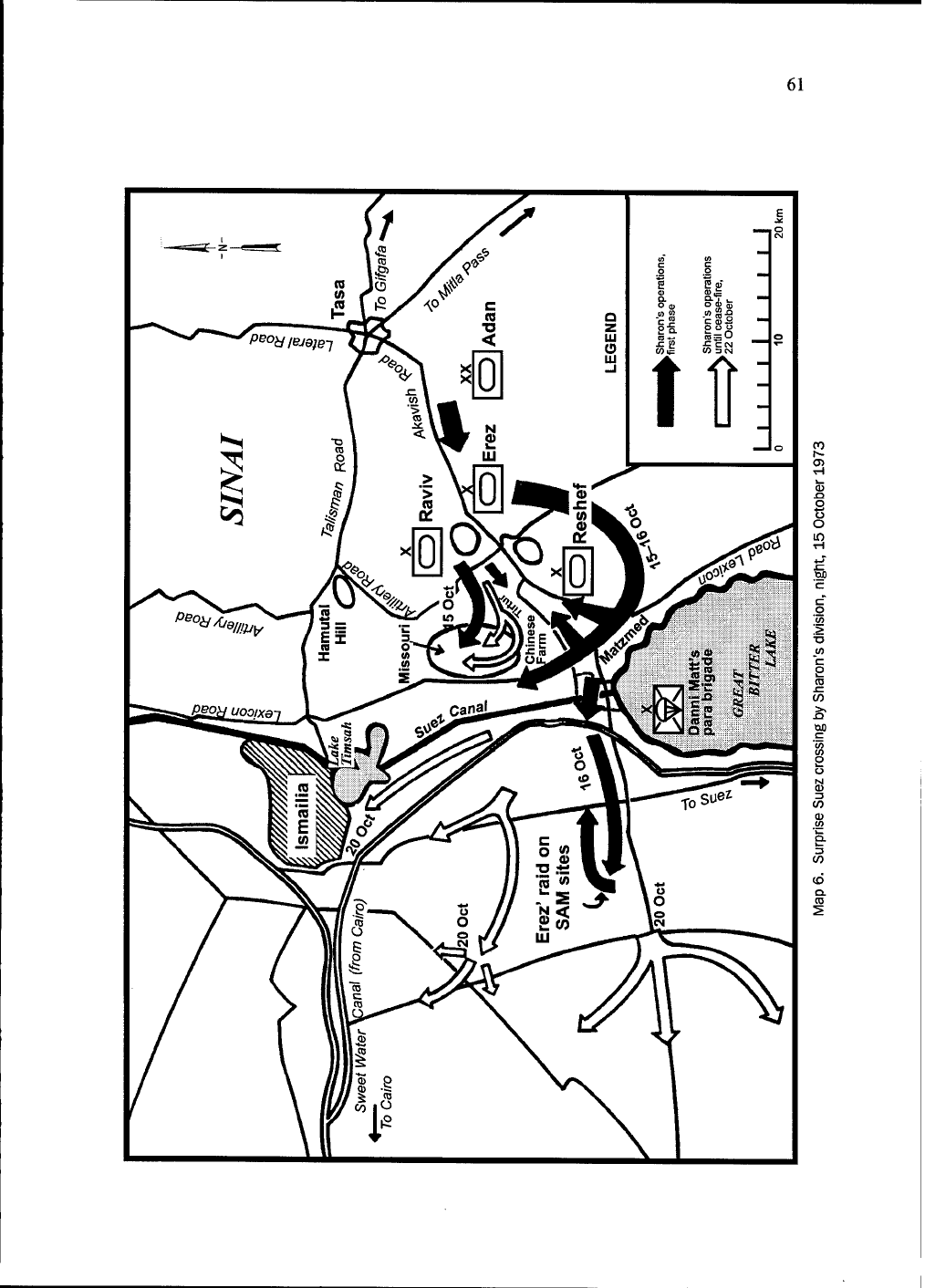
61
CO
05
%
o
'c
CO
Q.
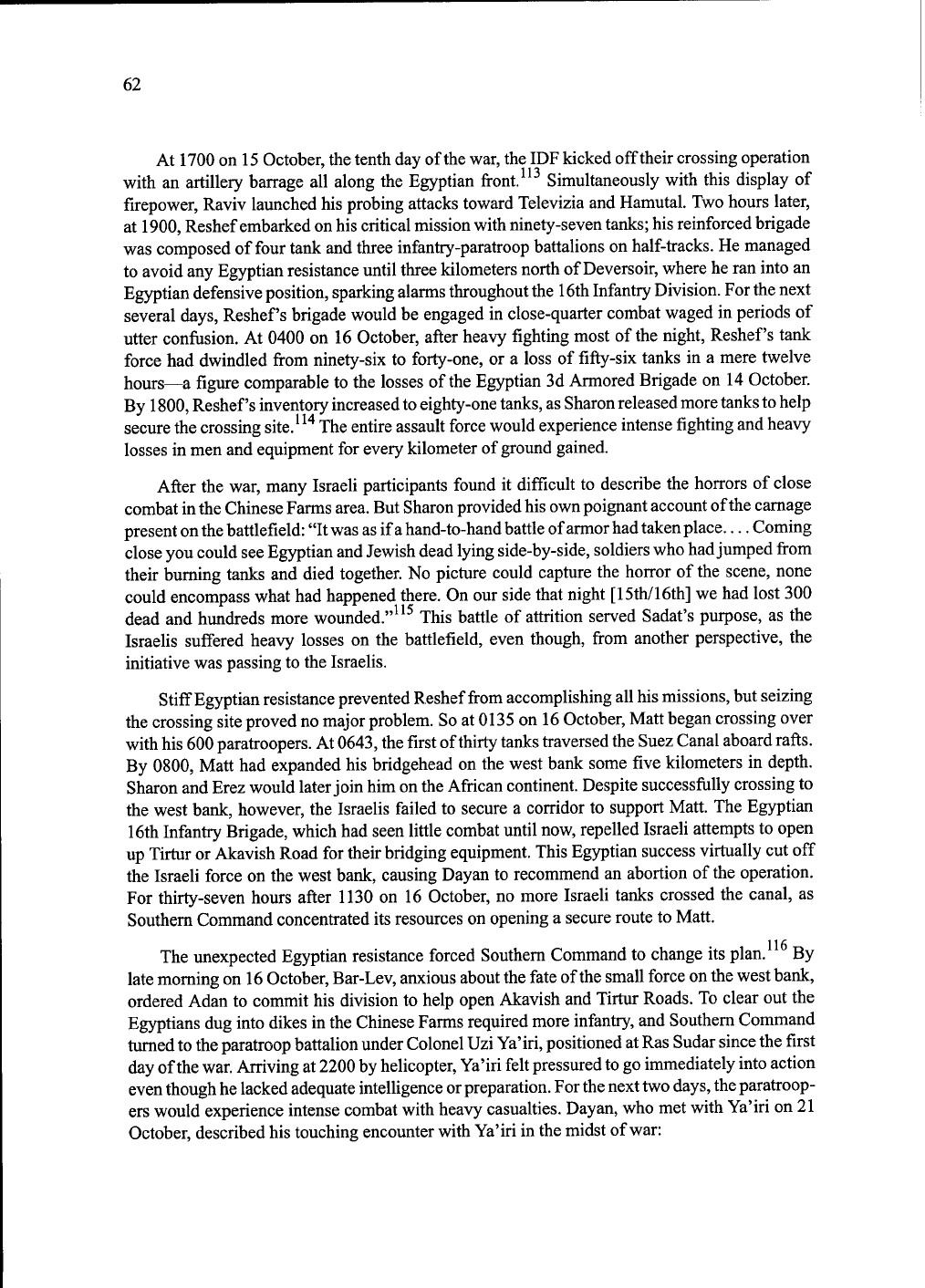
62
At
1700
on
15
October,
the
tenth
day
of
the
war,
the
IDF
kicked
off
their
crossing
operation
with
an
artillery
barrage
all
along
the
Egyptian
front.
1
1
3
Simultaneously
with
this
display
of
firepower,
Raviv
launched
his
probing
attacks
toward
Televizia
and
Hamutal.
Two
hours
later,
at
1900,
Reshef
embarked
on
his
critical
mission
with
ninety-seven
tanks;
his
reinforced
brigade
was
composed
of
four
tank
and
three
infantry-paratroop
battalions
on
half-tracks.
He
managed
to
avoid
any
Egyptian
resistance
until
three
kilometers
north
of
Deversoir,
where
he
ran
into
an
Egyptian
defensive
position,
sparking
alarms
throughout
the
16th
Infantry
Division.
For
the
next
several
days,
Reshef's
brigade
would
be
engaged
in
close-quarter
combat
waged
in
periods
of
utter
confusion.
At
0400
on
16
October,
after
heavy
fighting
most
of
the
night,
Reshef's
tank
force
had
dwindled
from
ninety-six
to
forty-one,
or
a
loss
of
fifty-six
tanks
in
a
mere
twelve
hours—a
figure
comparable
to
the
losses
of
the
Egyptian
3d
Armored
Brigade
on
14
October.
By
1800,
Reshef's
inventory
increased
to
eighty-one
tanks,
as
Sharon
released
more
tanks
to
help
secure
the
crossing
site.
1
1
4
The
entire
assault
force
would
experience
intense
fighting
and
heavy
losses
in
men
and
equipment
for
every
kilometer
of
ground
gained.
After
the
war,
many
Israeli
participants
found
it
difficult
to
describe
the
horrors
of
close
combat
in
the
Chinese
Farms
area.
But
Sharon
provided
his
own
poignant
account
of
the
carnage
present
on
the
battlefield:
"It
was
as
if
a
hand-to-hand
battle
of
armor
had
taken
place....
Coming
close
you
could
see
Egyptian
and
Jewish
dead
lying
side-by-side,
soldiers
who
had
jumped
from
their
burning
tanks
and
died
together.
No
picture
could
capture
the
horror
of
the
scene,
none
could
encompass
what
had
happened
there.
On
our
side
that
night
[15th/16th]
we
had
lost
300
dead
and
hundreds
more
wounded."
115
This
battle
of
attrition
served
Sadat's
purpose,
as
the
Israelis
suffered
heavy
losses
on
the
battlefield,
even
though,
from
another
perspective,
the
initiative
was
passing
to
the
Israelis.
Stiff
Egyptian
resistance
prevented
Reshef
from
accomplishing
all
his
missions,
but
seizing
the
crossing
site
proved
no
major
problem.
So
at
0135
on
16
October,
Matt
began
crossing
over
with
his
600
paratroopers.
At
0643,
the
first
of
thirty
tanks
traversed
the
Suez
Canal
aboard
rafts.
By
0800,
Matt
had
expanded
his
bridgehead
on
the
west
bank
some
five
kilometers
in
depth.
Sharon
and
Erez
would
later
join
him
on
the
African
continent.
Despite
successfully
crossing
to
the
west
bank,
however,
the
Israelis
failed
to
secure
a
corridor
to
support
Matt.
The
Egyptian
16th
Infantry
Brigade,
which
had
seen
little
combat
until
now,
repelled
Israeli
attempts
to
open
up
Tirtur
or
Akavish
Road
for
their
bridging
equipment.
This
Egyptian
success
virtually
cut
off
the
Israeli
force
on
the
west
bank,
causing
Dayan
to
recommend
an
abortion
of
the
operation.
For
thirty-seven
hours
after
1130
on
16
October,
no
more
Israeli
tanks
crossed
the
canal,
as
Southern
Command
concentrated
its
resources
on
opening
a
secure
route
to
Matt.
The
unexpected
Egyptian
resistance
forced
Southern
Command
to
change
its
plan.
By
late
morning
on
16
October,
Bar-Lev,
anxious
about
the
fate
of
the
small
force
on
the
west
bank,
ordered
Adan
to
commit
his
division
to
help
open
Akavish
and
Tirtur
Roads.
To
clear
out
the
Egyptians
dug
into
dikes
in
the
Chinese
Farms
required
more
infantry,
and
Southern
Command
turned
to
the
paratroop
battalion
under
Colonel
Uzi
Ya'iri,
positioned
at
Ras
Sudar
since
the
first
day
of
the
war.
Arriving
at
2200
by
helicopter,
Ya'iri
felt
pressured
to
go
immediately
into
action
even
though
he
lacked
adequate
intelligence
or
preparation.
For
the
next
two
days,
the
paratroop-
ers
would
experience
intense
combat
with
heavy
casualties.
Dayan,
who
met
with
Ya'iri
on
21
October,
described
his
touching
encounter
with
Ya'iri
in
the
midst
of
war:

63
Israeli
paratroopers
under
heavy
fire
in
the
"Chinese
Farm"
area
I
found
him
worn
out.
I
knew
him
well,
ever
since
he
had
headed
the
chief
of
staff's
bureau
under
Bar-Lev.
He
was
a
first-class
fellow,
straightforward,
sensible,
and
very
responsible.
I
knew
he
had
lost
a
lot
of
men
in
combat,
but
I
had
not
expected
to
find
him
so
downcast.
His
face
bore
an
expression
of
ineffable
sadness,
and
his
eyes,
swollen
from
lack
of
sleep,
were—what
was
worse—without
luster.
We
talked
about
his
battle
to
open
the
access
road
to
the
Canal.
Chaim
Bar-Lev,
who
was
with
me,
said,
"Uzi,
you
suffered
heavy
casualties,
but
you
opened
the
road!"
Uzi
held
to
his
own:
The
road
was
opened
not
by
me
but
by
the
armor.
I
would
like
to
be
able
to
say
that
my
unit
did
it,
but
this
was
not
so.
We
had
suffered
seventy
casualties
because
we
went
into
action
too
hastily,
without
proper
intelligence
on
the
enemy's
defenses.
117
Contrary
to
Ya'iri's
personal
assessment,
the
paratroopers
certainly
had
played
an
important
role
in
opening
the
access
road,
but
their
accomplishment
seemed
diminished
by
so
many
casualties.
After
the
war's
conclusion,
the
Israeli
public
would
express
similar
feelings,
but
this
time
with
political
ramifications.
Egyptian
soldiers
and
officers
demonstrated
unexpected
resolve
despite
the
emerging
serious
threat
to
their
rear.
Second
Army
directed
the
first
major
Egyptian
response,
which
occurred
on
16
October.
Second
Army
committed
the
1
st
Armored
Brigade
with
thirty-nine
tanks
and
the
18th
Mechanized
Infantry
Brigade
with
thirty-one
tanks
to
reinforce
the
southern
flank
of
the
16th
Infantry
Brigade.
Egyptian
armored
counterattacks
pushed
Reshef
southward
up
Lexicon
Road
for
several
kilometers,
while
the
mechanized
infantry
helped
secure
the
defensive
positions
in
the
Chinese
Farms
sector.
On
the
west
bank,
a
reinforced
battalion
from
the
Egyptian
116th
Mechanized
Infantry
Brigade
attacked
Mart's
small
force.
The
Israelis
managed
to
defeat
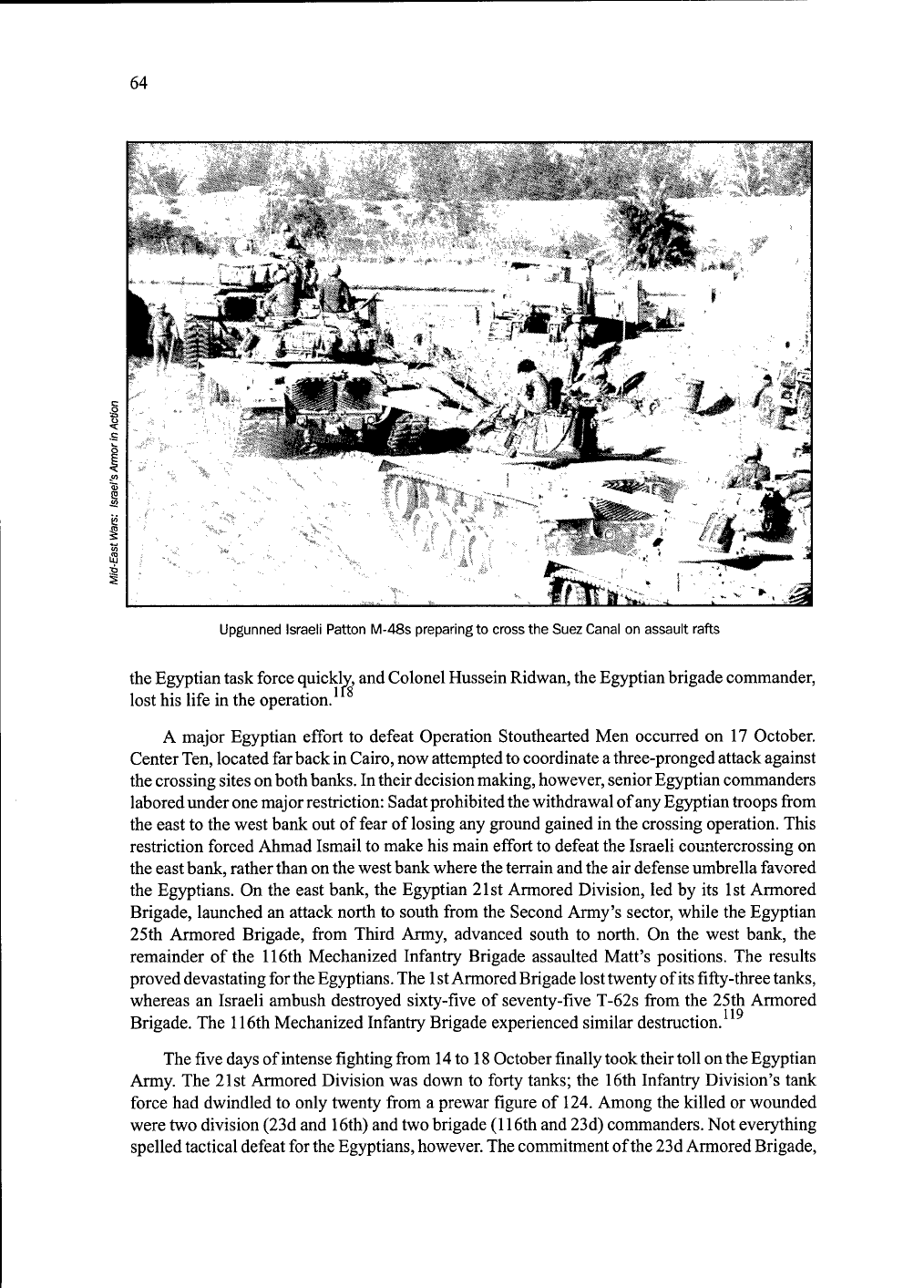
64
WSmmM
'HURI
Upgunned
Israeli
Patton
M-48s
preparing
to
cross
the
Suez
Canal
on
assault
rafts
the
Egyptian
task
force
quickly,
and
Colonel
Hussein
Ridwan,
the
Egyptian
brigade
commander,
lost
his
life
in
the
operation.
A
major
Egyptian
effort
to
defeat
Operation
Stouthearted
Men
occurred
on
17
October.
Center
Ten,
located
far
back
in
Cairo,
now
attempted
to
coordinate
a
three-pronged
attack
against
the
crossing
sites
on
both
banks.
In
their
decision
making,
however,
senior
Egyptian
commanders
labored
under
one
major
restriction:
Sadat
prohibited
the
withdrawal
of
any
Egyptian
troops
from
the
east
to
the
west
bank
out
of
fear
of
losing
any
ground
gained
in
the
crossing
operation.
This
restriction
forced
Ahmad
Ismail
to
make
his
main
effort
to
defeat
the
Israeli
countercrossing
on
the
east
bank,
rather
than
on
the
west
bank
where
the
terrain
and
the
air
defense
umbrella
favored
the
Egyptians.
On
the
east
bank,
the
Egyptian
21st
Armored
Division,
led
by
its
1st
Armored
Brigade,
launched
an
attack
north
to
south
from
the
Second
Army's
sector,
while
the
Egyptian
25th
Armored
Brigade,
from
Third
Army,
advanced
south
to
north.
On
the
west
bank,
the
remainder
of
the
116th
Mechanized
Infantry
Brigade
assaulted
Matt's
positions.
The
results
proved
devastating
for
the
Egyptians.
The
1
st
Armored
Brigade
lost
twenty
of
its
fifty-three
tanks,
whereas
an
Israeli
ambush
destroyed
sixty-five
of
seventy-five
T-62s
from
the
25th
Armored
Brigade.
The
116th
Mechanized
Infantry
Brigade
experienced
similar
destruction
119
The
five
days
of
intense
fighting
from
14
to
18
October
finally
took
their
toll
on
the
Egyptian
Army.
The
21st
Armored
Division
was
down
to
forty
tanks;
the
16th
Infantry
Division's
tank
force
had
dwindled
to
only
twenty
from
a
prewar
figure
of
124.
Among
the
killed
or
wounded
were
two
division
(23d
and
16th)
and
two
brigade
(116th
and
23d)
commanders.
Not
everything
spelled
tactical
defeat
for
the
Egyptians,
however.
The
commitment
of
the
23d
Armored
Brigade,
